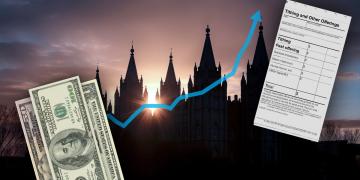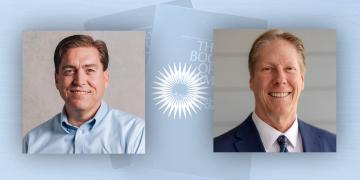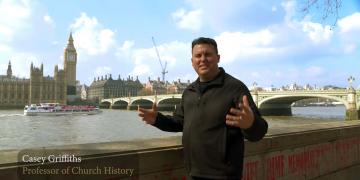You are here
Book of Mormon Central is in the process of migrating to our new Scripture Central website.
We ask for your patience during this transition. Over the coming weeks, all pages of bookofmormoncentral.org will be redirected to their corresponding page on scripturecentral.org, resulting in minimal disruption.
On Sunday, February 7, 2021 John W. Welch, Book of Mormon Central Chairman, and Kirk Magleby, Executive Director, gave a one-hour live presentation sponsored by the John A. Widtsoe Foundation entitled “Church History in a Technological Age.” Several hundred people watched the live stream and it is now posted on YouTube:
Welch and Magleby gave viewers a guided tour of Book of Mormon Central’s bountiful digital offering for the 2021 Doctrine and Covenants year, shared thoughts on the positive and negative effects technology has on our lives, then fielded a number of thoughtful questions from the audience.
Book of Mormon Central (BMC) publishes the largest array of Come Follow Me enrichment resources outside the official Church and it’s all available worldwide at no charge:
- The BMC web site offers KnoWhy articles, blog posts, and the ever-popular weekly BMC Come Follow Me Resource Guide which is a visual index linking to dozens of content items from BMC and other trusted publishers. Content that follows the 52 week Come Follow Me curriculum outline we post on BMC.
- The BMC YouTube Channel publishes a new video each day. Taylor Halverson and Tyler Griffin’s Come Follow Me Insights is the most-watched weekly Come Follow Me program in the Church. John Hilton III, Casey Paul Griffiths, Marianna Richardson and Stephanie Sorenson all add insightful perspectives and interesting facts to their weekly episodes. BMC KnoWhy videos round out this weekly YouTube cornucopia.
- The Doctrine and Covenants Central (DCC) web site offers quality enrichment material for each section in the Doctrine and Covenants. Here you will find John W. and Jeannie Welch’s Doctrine and Covenants by Themes and Sharon Anderson’s Praising the Prophet poems. A page for each section in the text has commentary by Steven Harper and verse-by-verse commentary by Casey Griffiths. Concise biographies by Susan Easton Black of all 135 people mentioned in the text are complimented by her fascinating section-by-section insights. Major historical sites each have a page that includes Ken Mays photos and 360-degree virtual tours.
- The DCC YouTube Channel has five different video series, all designed to broaden and deepen your understanding of Church History. BMC co-founder Lynne Wilson treats hard questions in Church History based on her years of teaching at the Stanford Institute. Anthony Sweat gives viewers a guided tour of the Unfolding Restoration and Scott Woodward’s animated videos of each section delight audiences young and old. Former BMC staffer Stephen Smoot shares thoughts on the First Vision based on the superb insights published on Pearl of Great Price Central. Church History and Doctrine and Covenants content that does not follow the 52 week Come Follow Me curriculum schedule we post on DCC.
- BMC has robust Come Follow Me offerings in both Spanish and Portuguese. The most-watched weekly Come Follow Me program in the Church in Spanish, for example, is Pepe Valle’s Ven, Sígueme on the BMC Spanish YouTube Channel.
- The BMC Archive is a convenient collection of thousands of digitized documents and files that facilitate in-depth study of God’s word. Book of Mormon content currently dominates in the archive, but important Doctrine and Covenants/Church History material is being added daily.
- Our most comprehensive offering is the superb ScripturePlus mobile app available for download on Apple, Android, and Kindle devices. Unfortunately, for the time being, it is only available in English and Spanish. Much of the content described above is on ScripturePlus, linked to verses in the scriptural text or to excellent, handy reading plans.
- People who don’t want to go searching for BMC content subscribe to our daily or weekly summary email lists and links to BMC material show up automatically in their inbox.
- In addition to BMC content, great Come Follow Me resources come from Church members worldwide who share via our popular Facebook groups in English, Spanish, and Portuguese.
This recent blog post describes the rich BMC content offerings for 2021 in greater detail.
2021 is a great time to study Church History and the Doctrine and Covenants with help from technology. Modern technology has democratized publishing. Many people are now able to produce very good digital content on limited budgets. There are dozens of Come Follow Me themed programs on the web, Facebook, Instagram, ITunes, YouTube, etc. Thanks to COVID, most of us are more comfortable using technology than ever before. So, in 2021, both supply of and demand for digital content are at all-time highs.
Technological developments in the last 5 years have made learning easier and, in many cases, more productive. High speed internet connections are now ubiquitous and wireless access is practically a given. Powerful mobile devices have largely replaced workstations. Videos are quickly becoming the media of choice for most people who consume information. The language barrier is not nearly as formidable as it once was. One click now renders a great deal of content in rough, but readable language translation. Speech to text engines are making transcripts of oral presentations much more common. Scanning now generally includes optical character recognition (OCR) which means the scanned image can not only be read visually but machine searched for words or phrases of interest. Amazing resources such as the Joseph Smith Papers project, Encyclopedia of Mormonism, and 50+ years of BYU Studies are now instantly available online.
On the downside, people’s attention spans are getting shorter. Power points have replaced text and now videos are replacing power points. Complex ideas get reduced to sharable “memes.” “Snackable” content tries to deliver a message in short sound bites. Facebook counts a video “view through” after only 10 seconds. YouTube counts a video “view” after only 22 seconds. In the old days people in a hurry skimmed through a magazine article reading only the photo and illustration captions. Nowadays, people “scrub” through a YouTube video, watching thumbnail images fly by as they move along the timeline. What does it mean to “ponder” and “feast upon” God’s word as we are commanded to do in 3 Nephi 17:3 and 2 Nephi 32:3? This kind of thoughtful study is possible in the digital age, but it takes discipline. Many of us flit around cyberspace like an insect gathering nectar from a thousand flowers when we should be drinking deeply from the well of living water (Doctrine and Covenants 63:23).
Can the Doctrine and Covenants help us today with our modern problems? Emphatically, yes. We think we live in a deeply divided culture. Joseph Smith did too. His America was fractured religiously, philosophically, geographically, politically, racially, ethnically, linguistically, economically, educationally, and in many other ways. Joseph sought answers to his and his associates’ questions. The revelations he received were needed for their time and they are needed today. Faith and study, repentance, baptism, revelation from the Holy Ghost, humility, obedience, tithing, the Word of Wisdom, missionary work, temple ordinances, family history, eternal marriage, the Second Coming, exaltation – the Doctrine and Covenants treats these and many other timeless themes in sublime, often soaring modern English. It is up to us to listen and hear the voice of the Lord (Doctrine and Covenants 72:1).
Just as no man is an island and humanity depends on interrelationships, so too with websites and high-tech channels. We need each other. As we cooperate, we become a thriving eco-system, part of a vibrant technological galaxy. The Church’s digital properties are at the center of this eco-system. Many BYU entities such as the Religious Studies Center are trusted partners. Increasingly, BMC is perceived as a vital, innovative part of this whole. We have Book of Mormon Central, Pearl of Great Price Central, Doctrine and Covenants Central, Evidence Central, Especially for Seminary, Messages of Christ, and ScripturePlus today. We are working on a biblically-based concept and some other very exciting future projects. The idea is to create a large fault-tolerant network of faith-affirming positivist messaging that supports the Church. Why can’t the Church with its vast resources just do everything itself? Because in today’s digitally interconnected world, even highly authoritative voices need a second. Heroes need a sidekick. Social proof (likes, shares, comments) is the digital coin of the realm and radical transparency is the lingua franca. As one of the Church’s trusted independent organizations (More Good Foundation is another), BMC supplies a great deal of social proof (we currently average 2 million user engagements each week) and we can afford to be transparent in ways the Church simply cannot. We are also much smaller which often makes us more nimble. For example, in consultation with the Church, we decided it would be good to get 360 degree tours of major Church History sites on Google Maps Street View. BMC was able to do it in days. Since we lacked the Church’s official imprimatur and we were still working the bugs out, we posted the files in the name of ScripturePlus. Weeks later, when legal paperwork was in order, we went back through and re-posted the same files in the name of the Church. We sourced, curated and in some cases commissioned the 360 imagery. We selected and implemented the technology. And eventually, we did it for the Church in their name. We have other content (3D models of early Temples) that the Church will never touch because of internal policies protecting the sanctity of the House of the Lord. They are OK, even excited to have BMC post this material in our name. This is one small example of a healthy, symbiotic eco-system at work.
Communication is what happens within the walls. Latin cum-muneo is to fortify. What is said meaningfully and purposefully within the protective walls of a home, within the semantic protocols of a language, and within the boundaries of a society: that’s communication. Ammunition is what is thrown at the walls. At BMC our stated purpose is to use technology to communicate, within the Church, with investigators, or interested outsiders. We build enduring faith in Jesus Christ by making the Book of Mormon and other Restoration scripture accessible, comprehensible, and defensible to people everywhere.
The Lord has always made use of the latest means of communication for the purpose of preaching, teaching, and administering the gospel. This has been the case at every crucial juncture in history. Where would Christianity have been without the Roman innovation of durable parchment-paged books, a technological giant step beyond fragile papyrus scrolls? And where would the Restoration have been without the proliferation of local printing presses? The first asset acquired by the Church was the printing press used in Kirtland to print Church periodicals, scriptures, and its first hymnbook. The Church has made amazing use of telegraphs, radio, television, computers, the internet, and now whole libraries of video and printed materials on demand, in languages worldwide.
In 1974, President Spencer W. Kimball said, “We shall use the inventions the Lord has given us to awaken interest and acquaint people of the world with the truths, to ease their prejudices and give them a general knowledge. We shall need to answer specific questions, and perhaps that can be done by two-way radio and TV perfected to a point beyond our present imagination.” That was long before widespread use of the Internet—or even thoughts of such—had permeated society. President Kimball believed that technology has been permitted by the Lord to be developed for the express purpose of building the kingdom.” In 2007, Elder M. Russell Ballard added, “we cannot stand on the sidelines while others . . . attempt to define what the Church teaches.”
Computers are undeniably powerful, and wherever there is power, there is also a potential for misuse or abuse. A hammer can be used to build up or to tear down. Use it carefully. Use it wisely. Use it intentionally. Touch not the unholy thing.
Where there is an upside, there must logically also be a downside. 100 years ago, T.S. Eliot identified one downside of “the vast accumulations of knowledge—or at least of information—deposited by the nineteenth century.” They “have been responsible for an equally vast ignorance. . . . [for] when everyone knows a little about a great many things, it becomes increasingly difficult for anyone to know whether he knows what he is talking about or not. And when we do not know, or when we do not know enough, we tend always to substitute emotions for thoughts.” (“The Perfect Critic,” 1920). Use it humbly. Use it with judgment. Use it with guidance from the Holy Ghost. People tend to view Wikipedia as the modern Oracle at Delphi – the fount of all wisdom. But Wikipedia is based on a consensus model, not a truth model. Where does the scriptural injunction to “seek ye out of the best books words of wisdom” (Doctrine and Covenants 88:118, 109:7, 14) fit in a consensus model where the majority cancels out a minority voice?
And thus, technology itself is not disconnected from truth and morals: We get the word “technology” from the Greek root word technes = which means “a skilled craftsman, one who handles a thing by the rules of art,” or one who “prescribes something as a rule of art” or “treats a subject systematically.” Thus, technology is both a consumer of and a servant of truth. It too cannot thrive in a world of chaos, of misrepresentations, or in a world out simply to make a business out of the rules of technology. Wherever there are rights, there are powers, and wherever there are powers, there are duties, because all powers can be used either for good or for bad. Use all this technology to build testimony, to enrich spiritual experiences, and to share the good news all over the world. “Flood the earth with the Book of Mormon” was President Ezra Taft Benson’s clarion call.
We’re closer today to being able to do that than ever before. L. Tom Perry said: It is “the challenge of each individual and family, through personal and collective study, to internalize the messages of the gospel of our Lord and Savior. Salvation is not in facilities or technology, but in the word. Only in the power of the word will it impact our lives and help us to live closer to our Father in Heaven.”
Subscribe
Get the latest updates on Book of Mormon topics and research for free








